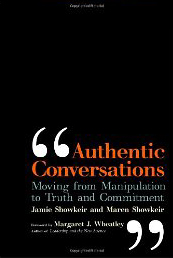BEDTIME BUSINESS CASE
Kari with Sawyer at age 7My long-time pal Karina Bland, a columnist for The Arizona Republic newspaper, recently used her column to take a trip down memory lane. She did what most parents do: Wondered how it is that one day you have an infant, the next day a toddler, and a week later a gangly teenager. As she chronicled some of her son’s exploits over the years, one line in particular jumped out: “This boy renegotiated his bedtime with a Power Point presentation.”
Kari was describing a process we recommend in our book Authentic Conversations: Moving from Manipulation to Truth and Commitment. Although our book discusses the ways parent-child dynamics in organizations sabotage good results, this particular parent-child conversation was a beautiful example of something we advocate. At age seven, her son managed to create a “business case” for a change he wanted, which also had the potential to be beneficial to the “family enterprise.”
In second grade, Sawyer’s teacher taught the kids how to do elementary power point presentations. His made the case for why he should get a later bedtime. Rather than just nag his mom — or whine that “all the other kids get to stay up late” — he gathered data, constructed an argument, and tied his case to things that “the business” (i.e. Mom) cared about.
First he did a poll of all the kids in his class to see what their bedtimes were. Most, although not all, were allowed to stay up later than he did. He created a simple table that showed where the numbers fell.
Second, he talked about how a later bedtime would give him opportunities for more learning, by watching the Discovery Channel, for instance, or other informative programming. This would tie into the vision of “the business” — raising a well-educated, well-rounded young man who would be come responsible and self-supporting.
Finally, he argued that because of their busy schedule and the demands of homework, very little time was left over in the evenings for quality mother-son time — to play cards, catch up on the day’s news, or read a book together before he had to go to bed.
“Sawyer presented me with good research and sound reasoning,” Kari says. “He appealed to my working mommy guilt about not spending enough time with him — without even knowing it. Honestly, I was impressed Besides, it was just so cute.”
Was it manipulative? Clearly, Kari’s decision was based partly on mommy guilt. But whether there was manipulative intent can only be answered by one person: Sawyer. Manipulation is purely a matter of intention.
His approach, however, did exactly what a good business case is supposed to do: propose a change, and show how it would be beneficial not just to him, but also to the enterprise. It wasn’t a childish demand: “Give me what I want or I’ll sulk or throw a tantrum.” Kari had good information on which to base her decision.
The presentation of his business case worked — Mom moved his bedtime 30 minutes later. Did the decision benefit the enterprise? As we’ve watched Sawyer grow into a smart, funny, and responsible young man, we would argue that his getting a little less sleep didn’t hurt the enterprise one little bit.


Reader Comments